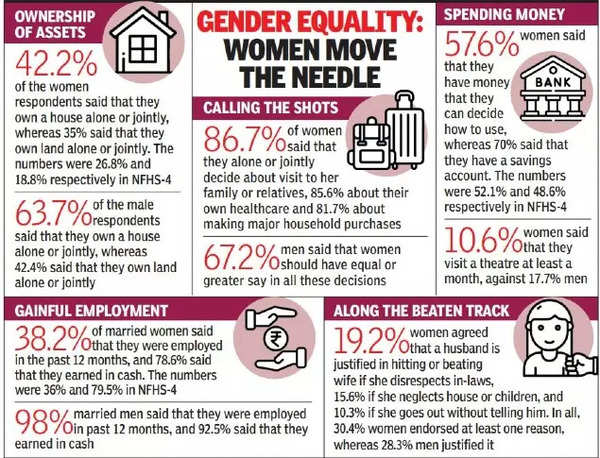- News
- City News
- ahmedabad News
- ‘Women in Gujarat earn higher or equal to husbands’
‘Women in Gujarat earn higher or equal to husbands’
Synopsis
While pay disparity based on gender is a topic troubling women CEOs to farm labourers, the National Family Health Survey (NFHS)-5 results claimed that Gujarat had the highest women respondents among Indian states claiming that they earned equal or higher than their husbands.

Against a national average of 39.9%, 53.2% women respondents in Gujarat said that they had pay parity (Representative image)
AHMEDABAD: While pay disparity based on gender is a topic troubling women CEOs to farm labourers, the National Family Health Survey (NFHS)-5 results claimed that Gujarat had the highest women respondents among Indian states claiming that they earned equal or higher than their husbands.
Against a national average of 39.9%, 53.2% women respondents in Gujarat said that they had pay parity. The number has increased significantly from 43.5% in NFHS-4 conducted in 2015-16. The survey conducted in 2019 covered 29,368 households in Gujarat including 33,343 women respondents.
 Out of the married women who were part of the survey, 38.2% said that they were engaged in employment. Out of total employed, 78.6% said that they had paid employment – the others got remuneration/ returns in kind.
Out of the married women who were part of the survey, 38.2% said that they were engaged in employment. Out of total employed, 78.6% said that they had paid employment – the others got remuneration/ returns in kind.
Across India, UTs of Diu, Daman, Dadra & Nagar Haveli had the highest women respondents (59.9%) who said they earned about the same or more than husband, followed by Gujarat (53.2%), Chandigarh (52.7%), Chhattisgarh (47.6%) and Arunachal Pradesh (47%).
In Gujarat, 90.5% of earning women respondents said that they have a say in how their earnings are used (alone or joint with husband), whereas 81.2% said that they have a say in how their husbands’ earnings are used. These numbers have also increased from 79.3% and 63.2% in the last survey.
Compared to NFHS-4, the women’s responses towards their participation in their health-related issues, capital expenditure and decision to visit relatives has also improved in NFHS-5 by 5% to 10%.
State-based NGOs working on women issues take the findings with a pinch of salt. Neeta Hardikar, co-founder of Anandi, said that the rise in employment could be due to schemes such as MNREGA expanding to districts where it was not available earlier and getting equal pay. “Education among women – both rural and urban – has increased phenomenally over the years, but the employment opportunities have not increased proportionally,” she said, adding that just having a say doesn’t mean it’s being implemented on.
Renu Khanna, director of Sahaj NGO, said that women have surely asserted their rights with rise in education and awareness, but scenarios are different in rural and urban Gujarat. “Post-Covid, women were the first who either left the job or didn’t get their jobs back at the earlier pay levels,” she said, adding that several other indices such as Periodic Labour Force Survey (PLFS) have shown glaring gender pay disparity in Gujarat.
84.3% of wives able to refuse sex: Study
Asserting their rights in a male-dominated world, 88% of women from Gujarat surveyed under National Family Health Survey (NFHS)-5, said that a wife is justified in refusing sex to her husband if ‘she is tired or not in the mood’. The number was 69.9% for the state in NFHS-4, whereas the national average is 86%. The survey also revealed that 86.3% women said that a wife is justified in refusing sex if the husband has a sexually transmitted disease, and 85.3% said that it is okay for a wife to refuse sex if she knows that the husband has sex with another woman.
About 80% of women agreed with all the reasons, whereas 68.8% of the men surveyed agreed with the same. The number of men agreeing with the reasons rose marginally from 62% in the last survey. Around 84.3% of married women from Gujarat said that they can say no to their husbands if they do not want to have sex. The national average was 82.4%.
The survey revealed that 13% of women from Gujarat had reported physical violence while 3% of them had reported sexual violence. The duration of the marriage or education did not matter when it came to sexual violence. In a section on safer sexual practices, 0.4% of women respondents and 0.9% of male respondents reported having two or more partners in the past 12 months.
Only about half of them reported using protection during their last intercourse. The mean number of sexual partners for women was 1.5 and for men was 1.7 against national average of 1.7 and 2.1 respectively. A city-based NGO working with women’s issues said that the scenarios are starkly different in the rural and urban settings. “Awareness about their own right over their body has surely increased, but socioeconomic factors come into play where physical relationships are concerned. These numbers are self-reported, and there are chances of exaggeration of reality,” said a social worker.
Against a national average of 39.9%, 53.2% women respondents in Gujarat said that they had pay parity. The number has increased significantly from 43.5% in NFHS-4 conducted in 2015-16. The survey conducted in 2019 covered 29,368 households in Gujarat including 33,343 women respondents.

Across India, UTs of Diu, Daman, Dadra & Nagar Haveli had the highest women respondents (59.9%) who said they earned about the same or more than husband, followed by Gujarat (53.2%), Chandigarh (52.7%), Chhattisgarh (47.6%) and Arunachal Pradesh (47%).
In Gujarat, 90.5% of earning women respondents said that they have a say in how their earnings are used (alone or joint with husband), whereas 81.2% said that they have a say in how their husbands’ earnings are used. These numbers have also increased from 79.3% and 63.2% in the last survey.
Compared to NFHS-4, the women’s responses towards their participation in their health-related issues, capital expenditure and decision to visit relatives has also improved in NFHS-5 by 5% to 10%.
State-based NGOs working on women issues take the findings with a pinch of salt. Neeta Hardikar, co-founder of Anandi, said that the rise in employment could be due to schemes such as MNREGA expanding to districts where it was not available earlier and getting equal pay. “Education among women – both rural and urban – has increased phenomenally over the years, but the employment opportunities have not increased proportionally,” she said, adding that just having a say doesn’t mean it’s being implemented on.
Renu Khanna, director of Sahaj NGO, said that women have surely asserted their rights with rise in education and awareness, but scenarios are different in rural and urban Gujarat. “Post-Covid, women were the first who either left the job or didn’t get their jobs back at the earlier pay levels,” she said, adding that several other indices such as Periodic Labour Force Survey (PLFS) have shown glaring gender pay disparity in Gujarat.
84.3% of wives able to refuse sex: Study
Asserting their rights in a male-dominated world, 88% of women from Gujarat surveyed under National Family Health Survey (NFHS)-5, said that a wife is justified in refusing sex to her husband if ‘she is tired or not in the mood’. The number was 69.9% for the state in NFHS-4, whereas the national average is 86%. The survey also revealed that 86.3% women said that a wife is justified in refusing sex if the husband has a sexually transmitted disease, and 85.3% said that it is okay for a wife to refuse sex if she knows that the husband has sex with another woman.
About 80% of women agreed with all the reasons, whereas 68.8% of the men surveyed agreed with the same. The number of men agreeing with the reasons rose marginally from 62% in the last survey. Around 84.3% of married women from Gujarat said that they can say no to their husbands if they do not want to have sex. The national average was 82.4%.
The survey revealed that 13% of women from Gujarat had reported physical violence while 3% of them had reported sexual violence. The duration of the marriage or education did not matter when it came to sexual violence. In a section on safer sexual practices, 0.4% of women respondents and 0.9% of male respondents reported having two or more partners in the past 12 months.
Only about half of them reported using protection during their last intercourse. The mean number of sexual partners for women was 1.5 and for men was 1.7 against national average of 1.7 and 2.1 respectively. A city-based NGO working with women’s issues said that the scenarios are starkly different in the rural and urban settings. “Awareness about their own right over their body has surely increased, but socioeconomic factors come into play where physical relationships are concerned. These numbers are self-reported, and there are chances of exaggeration of reality,” said a social worker.
FOLLOW US ON SOCIAL MEDIA
FacebookTwitterInstagram
Looking for Something?

Start a Conversation
end of article
Visual Stories
Quick Links
Delhi Air PollutionDelhi TemperatureChennai WeatherBangalore TemperatureCovid vaccination centres in DelhiCoronavirus in DelhiRTPCR test in GurgaonHyderabad RainPollution level in BangaloreDelhi SmogDelhi TemperatureNoida AQIGurgaon AQI todayFire in MumbaiMumbai RainsCovid 19 RT PCR Test in NoidaDelhi AQI todaySrinagar encounter

